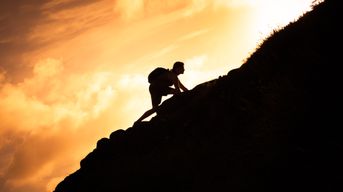Emotional Endurance

What are the emotion tools we need to go the distance in 2020 and beyond?
While we cultivate the endurance to cope with natural disasters, a national election, a bumpy economy and the daily roller coaster of COVID emotions, it occurred to us that we can all learn some valuable lessons from professional athletes who encounter – and overcome – big obstacles every day. That’s why our co-founders, Andrea Hoban and Robin Stern, Ph.D., recently moderated a fascinating discussion with Nascar driver Joey Gase; former NFL player, entrepreneur and current Chairman of the NFL Players Association, Tracy Porter; and Katie Spotz, endurance athlete/record-setting adventurer who rowed solo across the Atlantic to raise money for clean drinking water. Our panelists helped us to explore the concept of endurance and how physical and emotional endurance are related.
Consider the experiences of Katie Spotz. Even after a decade’s worth of endurance challenges, she has limits. During her 137 mile run across Maine, Katie “hit the wall” at mile 132, as she was overcome with doubt and fatigue. But for Katie, learning to manage those feelings is a core part of the challenge. “Endurance is really about being in touch with what we are designed to do. Our bodies and minds are innately endurance machines,” shared Katie, continuing that “emotional endurance is both the practice and the recognition of our abilities and capabilities to overcome and adapt through challenging situations.”
Here are some strategies to help you overcome and adapt through these challenging times.
Get Curious
At Oji Life Lab, we often talk about the way that curiosity drives our ability to engage with our emotions as an emotion scientist. Katie shared that, as an endurance athlete, one of the emotions she is very driven by is curiosity. “When we’re kids we have an explorer mindset - we don’t know if we can climb the tree or jump that high. Endurance is led by that curiosity to see what is possible and what we are capable of doing. I never expected to be able to do any of this - there is a thrill of living within some limits and being able to push beyond what was thought to be possible.” In what ways can we bring this explorer mindset to our emotions?
Prepare
On reflecting how to prepare for life’s challenges, Tracy Porter shared that practices such as reading or meditation help him to navigate the roller coaster of life - so, “I’m not high on the highs or too low on the lows.” Tracy’s experience is a reminder to think about how we can prepare a regulation toolkit to help us effectively shift from one emotion to another. “PRIME” can help us do just that. It’s an acronym for categories of strategies: Prevent, Reduce, Initiate, Maintain or Enhance. Practicing meditation is an effective way of preventing unwanted emotions from arising - these strategies require a little more planning like getting enough exercise, or a good night’s sleep.
Bringing his NASCAR experience to the (virtual) table, Joey Gase offered a strategy that falls into the “I” category of PRIME: Initiate – how can we initiate a feeling that helps us achieve our goals, in this case related to emotional endurance? For Joey, “getting into your car and putting on your helmet can put you into mentally prepared space to endure a long NASCAR run... once you get in the car and put that helmet on, everything else goes away. You get in your own zone. It goes beyond sports, maybe you’re getting ready to step into a board meeting, or you’re trying to help your kids tackle a difficult problem. Everyone has the ability to click and “get in the zone” to get through the task at hand.“
Rest to Regain Strength
How do you pace a solo row across the Atlantic? Or a 137 mile run? Katie shared how she tested her limits while rowing across the Atlantic, when she was rowing 10-12 hours a day. As Katie shared that sometimes “people think you’re gaining strength when you’re pumping iron or running the marathon when you’re doing the activity. Truthfully, strength is gained when your body has had the chance to rest, recover and rebuild the muscles that broke down. Rest & recovery were definitely a part of my training - otherwise you’re injured, you’re burnt out. Sports have shown me that rest is about regaining strength.”
Robin confirmed the importance of pausing and resting. “Sometimes we are exhausted when the journey seems like too much. But when you rest you are actually gathering your strength, you can reflect on how you got there to begin with and what you need to keep going. Those pauses and moments to collect yourself and take a deep breath are incredibly important.”
Acknowledge Fear
During her Atlantic row, Katie was alone at sea for 70 days. There was no helicopter, TV crew, or follow boat. She navigated 30 ft waves, fought sleep deprivation and even had to deal with a fire on her boat – fear-inducing situations for the hardiest of us. For Katie, “if I didn’t have fear, I’d probably be in a lot of dangerous situations. I’m very up front in saying yes, I brought fear with me, I brought doubt with me. When I first started doing endurance there was resistance and fear on top of the feeling. So you have the feeling and then you have the reaction to the feeling. It can compound and spiral.”
None of us are immune to feeling scared, anxious or fearful about what might happen. Here is some advice from Katie about how to cope with these kinds of emotions:
1) Say Thank You: Katie shared that she says “thank you” to her fears, “because fear can protect you from certain situations. Too much fear can be its own beast.”
2) Let Yourself Feel: Katie explained that when it comes to fear, she allows herself to feel those emotions. She continued that “of course I might have those feelings but then I continue to remind myself that feelings aren’t choices. You can still have those feelings and it doesn’t change the fact that we still have choice.”
3) See the Future: When things are looking grim, step back and see the bigger picture. As Katie explains, “you can feel like quitting and you can keep going. Sometimes the story line is, ‘I feel like quitting but in 24 hrs my emotions will be different’." If you can acknowledge that emotions come and go, it can be easier to wait out the darker moments.
4) Acceptance: According to Katie, when considering your feelings of fear, sometimes the best thing to do is to “just wait and give them space to express themselves - they don't always require action or reaction but simply acceptance and awareness and gratitude. What positive things can these even seemingly negative emotions can do for us? Like instilling humility or being able to connect with others?”
We can apply what we’ve endured through physical challenges to emotional challenges. Joey holds hope as a motivator and thinks about the positives of what could happen if he doesn’t give up or quit. Tracy focuses on what he can control - what is in front of him in the moment. Katie reminds us that even as an endurance runner and world record holder, “the hardest part is usually the first 20 minutes when you’re settling into this new change of pattern.” In other words, when the going gets tough, the tough adapt. As Robin Stern reminds us, “Emotions give us information - there is no bad emotion.” We can learn from our emotions and harness their power to help us survive - and perhaps even thrive - in the most challenging of circumstances. It takes time, but when you leverage strategies to regulate intense and difficult emotions, you too can get through the ultra marathon that is 2020.
Interested in learning more regulation strategies? Learn more about the Emotion Life Lab our comprehensive emotional intelligence training program.
Latest Posts
BACK TO HOME ❯ Developing New Managers? How to Set Them Up for Success
Developing New Managers? How to Set Them Up for Success
 First-time Managers Are Holding Back Employees & Performance
First-time Managers Are Holding Back Employees & Performance
 Why New Managers Fail and How Oji Foundations is Revitalizing Leadership Training
Why New Managers Fail and How Oji Foundations is Revitalizing Leadership Training
Sign up for our People-Powered Newsletter.
